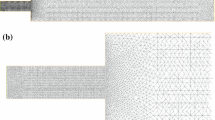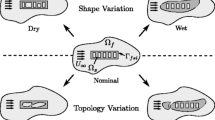Abstract
A derivative-free shape optimization tool for computational fluid dynamics (CFD) is developed in order to facilitate the implementation of complex flow solvers in the design procedure. A modified Rosenbrock’s method is used, which needs neither gradient evaluations nor approximations. This approach yields a robust and flexible tool and gives the capability of performing optimizations involving complex configurations and phenomena. The flow solver implemented solves the Reynolds-averaged Navier–Stokes equations (RANSE) on unstructured grids, using near-wall, low-Reynolds-number turbulence models. Free surface effects are taken into account by a pseudosteady surface tracking method. A mesh deformation strategy based on both lineal and torsional springs analogies is used to update the mesh while maintaining the quality of the grid near the wall for two-dimensional problems. A free-form-deformation technique is used to manage the mesh and the shape perturbations for three-dimensional cases. Two hydrodynamic applications are presented, concerning first the design of a two-dimensional hydrofoil in relation with the free-surface elevation and then the three-dimensional optimization of a hull shape, at full scale.
Similar content being viewed by others
References
Anderson, W.K.; Bonhaus, D.L. 1997: Aerodynamic design on unstructured grids for turbulent flows. NASA Technical Memorandum 112867
Anderson, W.K.; Nielsen, E. 1999: Aerodynamic design optimization on unstructured meshes using the Navier–Stokes equations. AIAA J.37, 1411–1419
Anderson, W.K.; Venkatakrishnan, V. 1999: Aerodynamic design optimization on unstructured grids with a continuous adjoint formulation. Comput. Fluids28, 443–480
Chen, P.; Huang, C. 2002: An inverse hull design problem in optimizing the desired wake of a ship. J. Ship Res.46, 138–147
Deng, G.; Guilmineau, E.; Queutey, P.; Visonneau, M. 2001: Capture et suivi d’interfaces d’ecoulements de fluides visqueux incompressibles non miscibles. 8e Journées de l’Hydrodynamique, Ecole Centrale de Nantes
Deng, G.; Visonneau, M. 1999: Comparison of explicit algebraic stress models and second-order turbulence closures for steady flows around ships. In: Proc. of the Seventh International Conference on Numerical Ship Hydrodynamics. Ecole Centrale de Nantes, Nantes, France
Deng, G.; Visonneau, M. 2000: Comparison of explicit algebraic stress models and second-order turbulence closures for steady flows around the kvlcc2 ship at model and full scales. In: A Workshop on Numerical Ship Hydrodynamics. Chalmers University of Technology, Göteborg
Duncan, J. 1983: The breaking and non-breaking wave resistance of a two-dimensional hydrofoil. J. Fluid Mech.126
Elliott, J.; Peraire, J. 1996: Practical 3d aerodynamic design and optimization using unstructured grids. AIAA J.35, 1479–1485
Farhat, C.; Degand, C.; Koobus, B.; Lesoinne, M. 1998: Torsional springs for two dimensional dynamic unstructured fluid meshes. Comput. Methods Appl. Mech. Eng. 231–245
Gill, P.E.; Murray, W.; Wright, M.H. 1981: Practical Optimization. Academic
Hino, T. 1999: Shape optimization of practical ship hull forms using Navier–Stokes analysis. In: Proc. of the 7th International Conference on Numerical Ship Hydrodynamics. Ecole Centrale de Nantes
Hovland, P.; Mohammadi, B.; Bischof, C. 1997: Automatic differentiation and Navier–Stokes computation. Technical Report ANL/MCS P687-0997, Mathematics and Computer Science Division, Argone National Laboratory
Jameson, A. 1988: Aerodynamic design via control theory. J. Sci. Comput.97, 233-260
Jameson, A.; Martinelli, L.; Pierce, N.A. 1998: Optimum aerodynamic design using the Navier–Stokes equations. Theor. Comput. Fluid Dynamics10, 213–237
Larsson, L.; Stern, F.; Bertram, V. 2000: Summary, conclusions and recommendations of the Gothenburg 2000 Workshop. In: A Workshop on Numerical Ship Hydrodynamics. Chalmers University of Technology, Göteborg
Lewis, R.; Torczon, V.; Trosset, M. 2000: Direct search methods: then and now. ICASE Rep.
Madsen, J. 2000: Response surface techniques for diffuser shape optimization. AIAA J.38, 1512–1518
Maute, K.; Nikbay, M.; Farhat, C. 2001: Coupled analytical sensitivity analysis and optimization of three-dimensional non-linear aeroelastic systems. AIAA J.39, 2051–2061
Menter, F. 1993: Zonal two-equations k-ω turbulence models for aerodynamic flows. AIAA paper 93-2906
Muzaferija, S.; Peric, M. 1998: Computation of free surface flows using interface-tracking and interface-capturing methods. Non linear Wave Interaction. Computational mechanics computations
Mason, W.; Watson, L. 1994: Noisy aerodynamic response and smooth approximations in HSCT design. AIAA paper 94-4316
Rhie, C.L.; Chow, W.L. 1982: A numerical study of the turbulent flow on an isolated airfoil with trailing edge separation. AIAA paper 82-0998, AIAA/ASME 3rd Joint Thermophysics Fluids, Plasma and Heat Transfer Conference
Rosenbrock, H.H. 1960: An automatic method for finding the greatest or least value of a function. Comp. J.3, 175–184
Sederberg, T.; Parry, S. 1986: Free-from deformation of solid geometric models. Comput. Graph.20, 151–160
Spalart, P.R.; Allmaras, S.R. 1991: A one-equation turbulence model for aerodynamic flows. AIAA Paper 92-0439
Swann, W.H. 1964: Report on the development of a new direct search method of optimization. Technical Report Research Note 64/3, ICI Central Instrument Laboratory
Van, S.; Kim, W.; Yim, D.; Lee, C.; Eom, J. 1998: Flow measurement around a 300KVLCC model. In: Proc. of the Annual Spring Meeting, SNAK. Ulsan
Author information
Authors and Affiliations
Corresponding author
Rights and permissions
About this article
Cite this article
Duvigneau, R., Visonneau, M. Hydrodynamic design using a derivative-free method. Struct Multidisc Optim 28, 195–205 (2004). https://doi.org/10.1007/s00158-004-0414-z
Received:
Revised:
Published:
Issue Date:
DOI: https://doi.org/10.1007/s00158-004-0414-z




